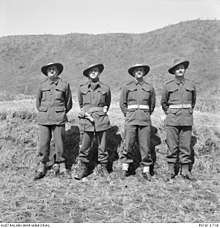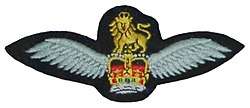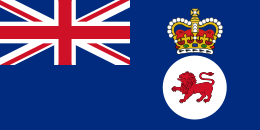Phillip Bennett
| General Sir Phillip Bennett AC, KBE, DSO | |
|---|---|
|
| |
| 23rd Governor of Tasmania | |
|
In office 19 October 1987 – 2 October 1995 | |
| Monarch | Queen Elizabeth II |
| Preceded by | Sir James Plimsoll |
| Succeeded by | Sir Guy Green |
| Personal details | |
| Born |
27 December 1928 East Fremantle, Western Australia |
| Nationality | Australian |
| Occupation | Soldier |
| Military service | |
| Allegiance | Australia |
| Service/branch | Australian Army |
| Years of service | 1946–1987 |
| Rank | General |
| Commands |
Chief of the Defence Force (1984–87) Chief of General Staff (1982–84) 1st Division (1977–79) 1st Battalion, Royal Australian Regiment (1967–69) 2nd Commando Company (1958–61) |
| Battles/wars |
Korean War Malayan Emergency Vietnam War |
| Awards |
Companion of the Order of Australia Knight Commander of the Order of the British Empire Distinguished Service Order Knight of the Order of St John Mentioned in Despatches Commander of the Legion of Merit (United States) |
General Sir Phillip Harvey Bennett AC, KBE, DSO (born 27 December 1928) is a retired senior officer of the Australian Army who served as Chief of the Australian Defence Force from 1984 to 1987, and later as Governor of Tasmania from 1987 to 1995.
Early life
Bennett was born in Perth, Western Australia, and educated at Perth Modern School and the Royal Military College, Duntroon, from which he graduated as a lieutenant on 14 December 1948. With 13 other new officers, he was posted in March 1949 to 67 Infantry Battalion, The Australian Regiment, then in the British Commonwealth Occupation Force, Japan.
Military career
Bennett served in Japan until September 1950 and then embarked with the 3rd Battalion, Royal Australian Regiment for Korea where he served for a year during which he was wounded in action on 14 October 1950, remaining on duty, and Mentioned in Despatches in 1951. He served again for 12 months in Korea from 1 September 1952 as Senior Instructor, then Chief Instructor, with the 25th Canadian Infantry Brigade Junior NCO School while posted as Tactics Instructor at the School of Infantry in Seymour, Victoria.

On return to Australia in 1953 he became the Adjutant of the 1st Battalion, Pacific Islands Regiment in PNG. In 1954 he was Adjutant with the 16th Infantry Battalion (CMF) and in 1956 Staff Captain A in HQ Western Command. In 1957–58 he served in the United Kingdom with the Royal Marine Commandos and saw duty in Malta, and operational service in Cyprus. He then served as OC 2nd Commando Company from July 1958 to June 1961,[1][2] and after attending the Australian Staff College, became the Senior Instructor, then Chief Instructor, at Officer Cadet School, Portsea from 1962 to 1965. He was then posted until 10 July 1967 to Army HQ which had moved to Canberra in the early 1960s from Melbourne.
He then commanded the 1st Battalion, Royal Australian Regiment and for service in Vietnam in 1968–69 and was awarded the Distinguished Service Order.[3] On return from UK Joint service training in 1971 he became Colonel Coordination in the office of Chief of the General Staff and in April 1974 was promoted to brigadier, Chief of Staff at HQ Field Force Command in Sydney until December 1975.
He attended senior officer training at the Australian Staff College first long course in 1960–61, Joint Services Staff College in UK as a student then exchange instructor 1969–71, and then the Royal College of Defence Studies in UK in 1976.
He commanded the 1st Division 1977–79, became Assistant Chief of Defence Staff 1979–82, Chief of the General Staff 1982–84 and Chief of the Defence Force in 1984 (the position having been changed from Chief of the Defence Staff). He retired from the Army in April 1987.[4]
Governor of Tasmania
During his period as governor, he was called on to be the adjudicator of a sensitive constitutional problem following the inconclusive Tasmanian state election in 1989. The Liberal Government of Premier Robin Gray had suffered a two-seat swing, leaving it one seat short of a majority. The opposition Labor Party led by Michael Field then garnered the support of the five Green members of the House of Assembly for a minority government in what was known as the Labor-Green Accord.
Gray refused to resign, initially intending to stay in office until defeated in the House. When he learned of the Labor-Green agreement, he asked Bennett to dissolve the legislature and call new elections. Under normal circumstances, Bennett would have been bound by convention to honour this request. However, Bennett refused to do so. He believed that Gray was no longer in a position to govern, and therefore had lost the right to ask for a dissolution. He'd also been privately assured before the formal accord was signed that the Greens would back a Labor government. Gray was thus forced to resign, and Bennett commissioned Field as premier.
Sir Phillip on several occasions also became Administrator of the Commonwealth during overseas visits by the then Governor-General, Bill Hayden.
Retirement
After retiring from the governorship, Sir Phillip has also served as inaugural Chairman of the Australian War Memorial Foundation. He has been the Patron of the 2 Commando Association (now the Australian Commando Association Victoria) since 1985,[5] Patron of The St John Ambulance in the ACT since 1996 and a past President of the Order of Australia Association (elected National President of the Order of Australian Association in March 1997). Bennett is also the inaugural National Patron of the Royal Australian Regiment Association.
Awards and honours
He was appointed a Companion of the Distinguished Service Order (DSO) in 1969 for service as Commanding Officer of the 1st Battalion, Royal Australian Regiment in Vietnam.[3] Bennett was made an Officer in the Military Division of the Order of Australia (AO) in 1981,[6] a Knight Commander in the Military Division of the Order of the British Empire (KBE) in 1982,[7] and was promoted to Companion of the Order of Australia (AC) in 1985.[8]
He was Mentioned in Despatches for; 'During the period, 9 November 1950 to June 1951, this officer performed the duty of mortar platoon commander through that period. His support of battalion attacks was of the highest order etc.'
In 1983 he was made a Commander of the US Legion of Merit, and in 1985 was awarded the Republic of Korea Order of National Security Medal. He was awarded an Honorary LLD (NSW) in October 1995 for his contribution to military education and the Australian Defence Force Academy. He was made a Knight of St John in 1988[9] and awarded the degree of Doctor of Laws, honoris causa, by the University of Tasmania in 1992. He was awarded the Centenary Medal in 2001.

![]()
![]()
![]()
![]()
![]()
![]()
![]()
![]()
![]()
![]()
![]()
![]()
![]()
![]()
![]()
![]()
![]()
![]()
![]()
| Companion of the Order of Australia (AC) | (1985)[8] | |
| Officer of the Order of Australia (AO) | (1981)[6] | |
| Knight Commander of the Order of the British Empire (KBE) | (1982)[7] | |
| Companion of the Distinguished Service Order (DSO) | (1969)[3] | |
| Knight of the Most Venerable Order of Saint John (KStJ) | (1988)[9] | |
| Australian Active Service Medal 1945-1975 | ||
| Korea Medal with Bronze Oakleaf for Mentioned in Dispatches | ||
| United Nations Korea Medal | ||
| General Service Medal (With Malaya clasp) | ||
| Vietnam Medal | ||
| Australian Service Medal 1945-1975 | ||
| Centenary Medal | (2001)[10] | |
| Defence Force Service Medal (with Federation Star) (5 clasps) | (40–44 years service) | |
| National Medal with two clasps | (1977)[11][12] (1982)[13] | |
| Australian Defence Medal | ||
| Vietnam Campaign Medal (Republic of Vietnam) | ||
| Commander of the Legion of Merit (United States of America) | (1983) | |
| Order of National Security Merit (Tong-il Medal) (South Korea) | (1985) | |
| Pingat Jasa Malaysia (Malaysia) | ||
| Korean War Service Medal (South Korea) |
References
- ↑ ADF Routine Orders Part 2 (166 - 209/6). 19 June 1961. Missing or empty
|title=(help) - ↑ Higgins, Barry (1995). Strike Swiftly 40 years of 2 Commando Company 1955 to 1995. Melbourne: 2 Cdo Assoc Victoria. pp. 82–84. ISBN 0 646 22208 2.
- 1 2 3 London Gazette: (Supplement) no. 44818, page 3365, 28 March 1969. (Distinguished Service Order)
- ↑ Chief of the Defence Force Archived 30 January 2009 at the Wayback Machine. - Previous Chiefs
- ↑ Higgins, Barry. "Australian Commando Association Victoria".
- 1 2 Officer of the Order of Australia (AO), 8 June 1981, It's an Honour.
- 1 2 London Gazette: (Supplement) no. 49213, page 44, 30 December 1982. (Knight Commander in the Military Division of the Order of the British Empire)
- 1 2 Companion of the Order of Australia (AC), 10 June 1985, It's an Honour.
- 1 2 London Gazette: (Supplement) no. 51204, page 687, 21 January 1988 (Knight of St John)
- ↑ Centenary Medal, 1 January 2001], It's an Honour
- ↑ National Medal, 14 July 1977, It's an Honour
- ↑ National Medal - first clasp, 14 July 1977, It's an Honour
- ↑ National Medal - second clasp, 13 May 1982, It's an Honour
External links
| Military offices | ||
|---|---|---|
| New title Position replaced Chief of Defence Force Staff |
Chief of the Defence Force 1984–1987 |
Succeeded by General Peter Gration |
| Preceded by Air Chief Marshal Sir Neville McNamara |
Chief of Defence Force Staff April – October 1984 |
Position replaced by Chief of the Defence Force |
| Preceded by Lieutenant General Sir Donald Dunstan |
Chief of General Staff 1982–1984 |
Succeeded by Lieutenant General Peter Gration |
| Preceded by Major General Bruce McDonald |
Commander 1st Division 1977–1979 |
Succeeded by Major General John Kelly |
| Government offices | ||
| Preceded by Sir James Plimsoll |
Governor of Tasmania 1987–1994 |
Succeeded by Sir Guy Green |

